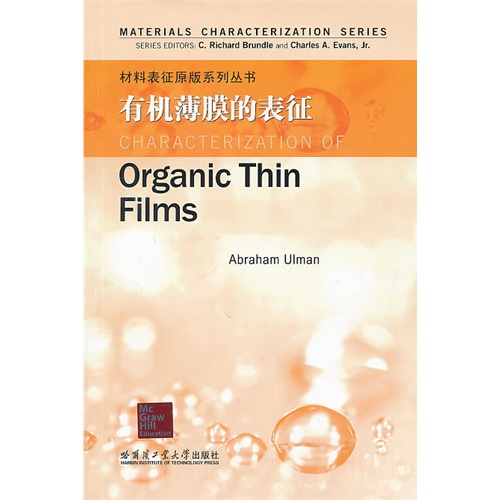- ISBN:9787560342870
- 装帧:一般胶版纸
- 册数:暂无
- 重量:暂无
- 开本:23cm
- 页数:276
- 出版时间:2014-01-01
- 条形码:9787560342870 ; 978-7-5603-4287-0
本书特色
《材料表征原版系列丛书:有机薄膜的表征(英文)》主要内容包括:preparation and materials langmuir—blodgett films、l—b films oflong—chain compounds、cyclic compounds and chromophores、polymers and proteins、polymerization in situ、alternation films (superlattices)、self—assembled monoiayers等。
内容简介
《材料表征原版系列丛书:有机薄膜的表征(英文)》主要内容包括:PREPARATION AND MATERIALS LANGMUIR—BLODGETT FILMS、L—B Films ofLong—Chain Compounds、Cyclic Compounds and Chromophores、Polymers and Proteins、Polymerization In Situ、Alternation Films (Superlattices)、SELF—ASSEMBLED MONOIAYERS等。
目录
preface to series
preface to the reissue of characterization of organic thin films
preface
contributors
part ⅰ: preparation and materials langmuir—blodgett films
1.1 introduction
1.2 l—b films oflong—chain compounds
fattyacids
amines
other long—chain compounds
1.3 cyclic compounds and chromophores
1.4 polymers and proteins
1.5 polymerization in situ
1.6 alternation films (superlattices)
1.7 potentiaiapplications
self—assembled monoiayers
2.1 introduction
2.2 monolayers of fatty acids
2.3 monolayers of organosilicon derivatives
2.4 monolayers of alkanethiolates on metal and semiconductor surfaces
2.5 self—assembled monolayers containing aromatic groups
2.6 conclusions
partⅱ: analysis of film and surfaceproperties
spectroscopic ellipsometry
3.1 introduction and overview
3.2 theory of ellipsometry
3.3 instrumentation
3.4 determination of optical properties
analysis of single eliipsometric spectra: direct inversion methods
analysis of single ellipsometric spectra: least— squares regression analysis method
analysis of multiple ellipsometric spectra
3.5 determination of thin film structure
thickness determination for monolayers
microstructural evolution in thick film growth
3.6 future prospects
infrared spectroscopyin the characterization of organic thin films
4.1 introduction
specific needs for characterizing organic thin films
general prinaples and capabilities of infrared spectroscopy for surface and thin film analysis
4.2 quantitative aspects
spectroscopiclntensities
electromagnetic fields in thin film structures
4.3 the infrared spectroscopic experiment
general instrumentation
experimental modes
additional aspects
4.4 examples of applications
self—assembled monolayers on gold by external reflection
octadecylsiloxane monolayers on sio2 bytransmission
langmuir—blodgett films on nonmetallic substrates by external reflection
raman spectroscopic characterization of organic thin films
5.1 introduction
5.2 fundamentalsoframan spectroscopy
5.3 instrumentaiconsiderations
5.4 raman spectroscopic approaches for the characterization oforganicthin films
integrated opticaiwaveguide raman spectroscopy (iowrs)
total internal reflection raman spectroscopy
surface enhanced raman scattering
normal raman spectroscopy
resonance raman spectroscopy
plasmon surface polariton enhanced raman spectroscopy
fouriertransform raman spectroscopy
waveguide surface coherent anti—stokes raman spectroscopy(wscars)
5.5 selected examples of thin film analyses
raman spectral characterization of langmuir—blodgett layers of arachidate and stearate salts
raman spectral characterization of self—assembled monolayers of alkanethiols on metals
surface enhanced resonance raman spectral characterization of langmuir—blodgett layers of phthalocyanines
5.6 prospects for raman spectroscopic characterization of thin films
surface potential
6.1 introduction
6.2 origins of the contact potential difference and surface potential
the work function
contact potential difference and surface potential
surface potential changes induced by adsorbates
6.3 measurement of surface potential
capacitancetechniques
ionizing—probetechnique
6.4 surface potentials of organicthin films
air—water interface: surface potential of langmuir mono— layers
air—solidlnterface: surface potential of l—b and related films
6.5 conclusions
x—ray diffraction
7.1 introduction
7.2 basic principles
7.3 structure normal to film plane
7.4 structure within the film plane
7.5 summary
high resolution eels studies of organic thin films and surfaces
8.1 introduction
8.2 thescatteringmechanism
dipolescattering
impact scattering
resonance scattering
8.3 thespectrometer
8.4 eels versus other techniques: advantages and disadvantages
8.5 examples
resolutionenhancement
linearity
depth sensitivity
molecular orientation
local versus long—range lnteractions
surfaces egregation
8.6 conclusions
wetting
9.1 introduction
9.2 contactangles
9.3 techniques for contact angle measurements
axisymmetric drop shapeanalysis—profile (adsa—p)
axisymmetric drop shape analysis—contact diameter (adsa—cd)
capillary rise technique
9.4 phase rule for moderately curved surface systems
9.5 equation of state forinterfacialtensions of solid— liquid systems
9.6 drop size dependence of contact angle and line tension
9.7 contact angles in the presence ofa thin liquid film
9.8 effects ofelastic liquid—vaporlnterfaces on wetting
secondary ion mass spectrometry as applied to thin organic and polymeric films
10.1 introduction and background
overview of the sims method and experiment
ion formationmechanisms
comparisons to other surface analysis techniques
the motivation for thin organic films as model systems
10.2 qualitative information: mechanisms ofsecondary molecularlon formation
structure—ion formation relationships
applications to self—assembled film chemistry
10.3 the study ofsampling depth in the sims experiment
10.4 quantitationin sims
development of quantitation methods
applicationof quantitative schemes to thin film chemistry
10.5 imagingapplications
10.6 summary and prospects
x—ray photoelectron spectroscopy of organic thin films
11.1 introduction
11.2 experimental considerations
11.3 binding energy shifts
11.4 xps of molten films
11.5 angular dependent xps
11.6 etoaxps of self—assembled monolayers
11.7 conclusions
molecular orientation in thin films as probed by optical second harmonic generation
12.1 introduction
12.2 experimental considerations
12.3 molecular nonlinear polarizabiliry calculation
12.4 measurements of the surface nonlinear susceptibility
12.5 molecular orientation calculation
casel:βzzzonly
case2:βzxxonly
case3: βxxz(=βxzx)only
case4:βzzz and βzxx
case5: βzxx and βxxz(=βxzx)
12.6 absolute molecular orientation measurements
12.7 summary and conclusions
appendix: technique summaries
i auger electron spectroscopy(aes)
2 dynamicsecondarylon mass spectrometry (dynamicsims) 252
3 fouriertransformlnfraredspectroscopy(ftir) 253
4 high—resolution electron energy loss spectroscopy (hreels)
5 low—energy electron diffraction(leed)
6 raman spectroscopy
7 scanning electron microscopy(sem)
8 scanning tunneling microscopy(stm) and scanning force microscopy (sfm)
9 static secondarylon mass spectrometry (static sims)
10 transmission electron microscopy(tem)
11 variable—angle spectroscopic ellipsometry(vase)
12 x—ray diffraction xrd)
13 x—ray fluorescence(xrf)
14 x—ray photoelectron spectroscopy(xps)
index
作者简介
作者:(美国)布伦德尔(C.Richard Brundle) (美国)埃文斯(Charles A.Evans) (美国)乌尔曼(Abraham Ulman) 乌尔曼(Abraham Ulman),Analytical tools for the study of organic thin films have seen dramatic developments in the last decade.Using such tools it has become possible to obtain structural information at the molecular level and thus to relate materials structure to materials properties.Characterization of Organic Thin Films will help materials scientists, physicists, chemists, and biologists develop a fundamental understanding of structure—properties relationships which in turn makes possible molecular engineering of advanced materials and opens new opportunities in molecular manufacturing.This volume begins with introduc—tory chapters on Langmuir—Blodgett and self—assembled films, and continues with the discussion of their properties as studied by different analytical tech—niques.Both their surface/interfacial and bulk properties are covered.
-

港口文化
¥22.2¥60.0 -

电子操作工必读
¥2.3¥8.0 -

生态环境检测机构资质认定常见问题及解决方案
¥40.1¥118.0 -

黑科技驱动世界的100项技术
¥24.4¥69.8 -

损伤力学手册
¥271.6¥388.0 -

磷腈阻燃材料(精)
¥118.5¥158.0 -

环境监测人员持证上岗考核试题集上册(第五版)
¥61.2¥180.0 -

服装材料的选用与性能分析
¥19.2¥52.0 -

食品工艺学
¥40.6¥58.0 -

中国古代重要科技发明创造
¥38.7¥90.0 -

世界桥梁趣谈
¥14.0¥28.0 -

服装结构制图
¥15.2¥39.0 -

超大型储罐与应用
¥15.4¥48.0 -

服装制作基本技能
¥3.5¥10.0 -

进步简史
¥11.4¥30.0 -

环境保护辞典
¥16.7¥45.0 -

消防安全管理技术(第二版)
¥45.8¥58.0 -

电工基础
¥6.2¥14.5 -

煤矿机电设备技术管理
¥32.3¥38.0 -

航天装备试验概论
¥45.6¥76.0











